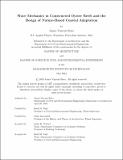Wave Mechanics in Constructed Oyster Reefs and the Design of Nature-Based Coastal Adaptation
Author(s)
Brice, James Vincent
DownloadThesis PDF (25.50Mb)
Advisor
Nepf, Heidi M.
Jarzombek, Mark
Terms of use
Metadata
Show full item recordAbstract
There has been great interest in the potential of constructed oyster reefs (CORs) to function as nature-based coastal protection infrastructure, but most projects to-date are designed primarily for wave attenuation and fail to consider both the environmental conditions necessary for long-term oyster reef sustainability as well as the importance of education and outreach in fostering environmental stewardship. Realizing the promise of nature-based coastal adaptation means building physical, ecological and social infrastructure simultaneously, requiring a design-research methodology that combines an understanding of biological design constraints, physical analysis and community engagement.
Physical and numerical wave flume experiments were conducted to investigate mechanisms of wave energy loss in oyster shell gabion-type CORs that place oyster biology in the foreground— particularly, the influence of across-shore width, spacing and structure porosity on wave attenuation under non-breaking wave conditions. Gabion widths of O(1) wavelength were found to attenuate waves by 40%. These losses were driven primarily by internal drag which was characterized experimentally and accurately modeled with the modified Ergun Equations and the waves2Foam library of the open-source CFD software OpenFOAM.
This research was then translated into a suite of interactive design activities, featuring a tabletop wave flume, scale models of coastal features, and a set of coastal community member cards. Through design and creative inquiry, these tools seek to communicate complex biophysical processes in coastal ecosystems while empowering communities to reimagine what it really means to "build with nature".
Date issued
2024-05Department
Massachusetts Institute of Technology. Department of Architecture; Massachusetts Institute of Technology. Department of Civil and Environmental EngineeringPublisher
Massachusetts Institute of Technology